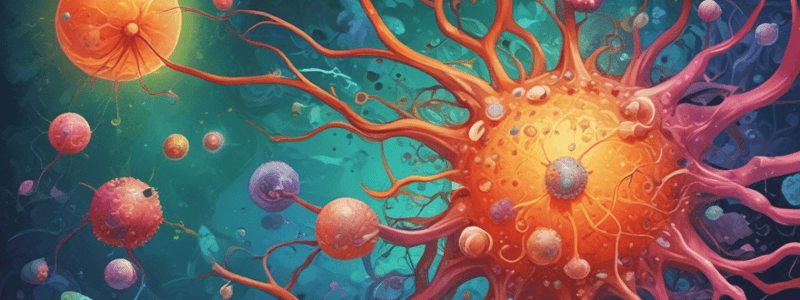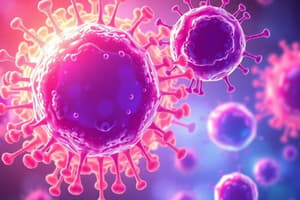Podcast
Questions and Answers
What is the primary function of the Fc region of an antibody?
What is the primary function of the Fc region of an antibody?
- Neutralising toxins and viruses
- Differentiating into plasma cells
- Mediating antibody-dependent cell-mediated cytotoxicity
- Determining the range of functions facilitated by the antibody (correct)
What is the primary mechanism by which antibodies facilitate phagocytosis?
What is the primary mechanism by which antibodies facilitate phagocytosis?
- Opsonisation of pathogens (correct)
- Agglutination of particles
- Activation of the complement cascade
- Neutralisation of toxins
During B cell development, when does the initial generation of diversity occur?
During B cell development, when does the initial generation of diversity occur?
- After exposure to exogenous antigen
- As the cells are first formed, before exposure to exogenous antigen (correct)
- During the differentiation into plasma cells
- During the activation of the complement cascade
What is the primary function of antibody-dependent cell-mediated cytotoxicity (ADCC)?
What is the primary function of antibody-dependent cell-mediated cytotoxicity (ADCC)?
What is the primary role of antibodies in the context of pathogens?
What is the primary role of antibodies in the context of pathogens?
What is the primary goal of having a diverse repertoire of lymphocytes in the adaptive immune system?
What is the primary goal of having a diverse repertoire of lymphocytes in the adaptive immune system?
What is the main difference between T cell receptors and B cell receptors?
What is the main difference between T cell receptors and B cell receptors?
What is the primary function of the germinal center in B cell activation?
What is the primary function of the germinal center in B cell activation?
What is the term for the process by which B cells change the isotype of their antibody while maintaining the same antigen specificity?
What is the term for the process by which B cells change the isotype of their antibody while maintaining the same antigen specificity?
What is the main difference between T-dependent and T-independent B cell responses?
What is the main difference between T-dependent and T-independent B cell responses?
What is the primary function of B cells in the adaptive immune system?
What is the primary function of B cells in the adaptive immune system?
What are the enzymes responsible for recombination of immunoglobulin genes?
What are the enzymes responsible for recombination of immunoglobulin genes?
What is the combination of gene segments used to form the heavy chain of an antibody?
What is the combination of gene segments used to form the heavy chain of an antibody?
How many proteins can be encoded by the IGHV regions if each protein is encoded by a single gene?
How many proteins can be encoded by the IGHV regions if each protein is encoded by a single gene?
What is the purpose of gene rearrangement in immunoglobulin genes?
What is the purpose of gene rearrangement in immunoglobulin genes?
How many proteins can be encoded by the IGHV regions if each protein is encoded by a combination of group 1, group 2, and group 3?
How many proteins can be encoded by the IGHV regions if each protein is encoded by a combination of group 1, group 2, and group 3?
What is the composition of the light chain of an antibody?
What is the composition of the light chain of an antibody?
Where does the gene rearrangement of T cell receptors occur?
Where does the gene rearrangement of T cell receptors occur?
What is required for both affinity maturation and class switching in B cells?
What is required for both affinity maturation and class switching in B cells?
Which type of antigen does not require reference to a specific receptor for activation?
Which type of antigen does not require reference to a specific receptor for activation?
What is the result of cross-linking of multiple receptors on the B cell surface?
What is the result of cross-linking of multiple receptors on the B cell surface?
Which cells are involved in providing cytokine help to B cells during T-independent type II activation?
Which cells are involved in providing cytokine help to B cells during T-independent type II activation?
What is the name of the enzyme required for both affinity maturation and class switching in B cells?
What is the name of the enzyme required for both affinity maturation and class switching in B cells?
What is the primary function of CD40-CD40L signaling in T-dependent B cell development?
What is the primary function of CD40-CD40L signaling in T-dependent B cell development?
What is the role of TCR 'Signal 1' in B-T cell interactions?
What is the role of TCR 'Signal 1' in B-T cell interactions?
Which chemokines are involved in the development of the germinal center?
Which chemokines are involved in the development of the germinal center?
What is the primary function of B cells in T-dependent protein antigen responses?
What is the primary function of B cells in T-dependent protein antigen responses?
What is the outcome of CD40-CD40L signaling in T-dependent B cell development?
What is the outcome of CD40-CD40L signaling in T-dependent B cell development?
Gene rearrangement occurs in the Bursa Fabricus in chickens.
Gene rearrangement occurs in the Bursa Fabricus in chickens.
The Fc region of an antibody determines the antigen specificity.
The Fc region of an antibody determines the antigen specificity.
Class switching occurs through gene rearrangement.
Class switching occurs through gene rearrangement.
B cell receptors can recognize peptide antigen presented to it by MHC on other cells.
B cell receptors can recognize peptide antigen presented to it by MHC on other cells.
The human genome has enough genes to create a unique antibody for every possible pathogen.
The human genome has enough genes to create a unique antibody for every possible pathogen.
Isotype class-switching, somatic hypermutation, and affinity maturation are all mechanisms to generate a diverse repertoire of lymphocytes.
Isotype class-switching, somatic hypermutation, and affinity maturation are all mechanisms to generate a diverse repertoire of lymphocytes.
The VDJ gene rearrangement is responsible for creating the light chain of an antibody.
The VDJ gene rearrangement is responsible for creating the light chain of an antibody.
Heterodimer formation occurs in B cell receptor structure.
Heterodimer formation occurs in B cell receptor structure.
T cell help is required for the activation of B cells in T-independent B cell responses.
T cell help is required for the activation of B cells in T-independent B cell responses.
The primary function of B cells is to provide cytokine help to T cells during T-dependent B cell responses.
The primary function of B cells is to provide cytokine help to T cells during T-dependent B cell responses.
The germinal center is a location where B cells undergo initial generation of diversity.
The germinal center is a location where B cells undergo initial generation of diversity.
The Fc region of an antibody determines its antigen specificity.
The Fc region of an antibody determines its antigen specificity.
The RAG1 and RAG2 enzymes are responsible for the rearrangement of T cell receptors.
The RAG1 and RAG2 enzymes are responsible for the rearrangement of T cell receptors.
The combination of gene segments used to form the light chain of an antibody is VDJ.
The combination of gene segments used to form the light chain of an antibody is VDJ.
The IGHV regions can encode up to 9 proteins if each protein is encoded by a single gene.
The IGHV regions can encode up to 9 proteins if each protein is encoded by a single gene.
The gene segments used to form the heavy chain of an antibody are V, D, and J.
The gene segments used to form the heavy chain of an antibody are V, D, and J.
The gene rearrangement of immunoglobulin genes occurs in the germinal center.
The gene rearrangement of immunoglobulin genes occurs in the germinal center.
The mathematics of combinatorial diversity allows for the generation of up to 24 proteins from the IGHV regions.
The mathematics of combinatorial diversity allows for the generation of up to 24 proteins from the IGHV regions.
The number of different Ig gene possibilities is exactly 5 million due to the junctional region diversity.
The number of different Ig gene possibilities is exactly 5 million due to the junctional region diversity.
Class switching involves changing the antigen specificity in the Variable region.
Class switching involves changing the antigen specificity in the Variable region.
IgM is a membrane-bound form of Immunoglobulin on Naïve B cells.
IgM is a membrane-bound form of Immunoglobulin on Naïve B cells.
The Fc region enables the molecules to diffuse into tissues or cross the placenta.
The Fc region enables the molecules to diffuse into tissues or cross the placenta.
The enzyme TdT is responsible for randomly removing nucleotides from the J region.
The enzyme TdT is responsible for randomly removing nucleotides from the J region.
The human immune system can produce approximately 1 million different antibodies.
The human immune system can produce approximately 1 million different antibodies.
B cells process the protein and present the peptide antigen on the surface with MHC class I molecules in order to recruit T cell help for the response.
B cells process the protein and present the peptide antigen on the surface with MHC class I molecules in order to recruit T cell help for the response.
CD40-CD40L signaling is involved in the inhibition of cell death in B cells.
CD40-CD40L signaling is involved in the inhibition of cell death in B cells.
T-independent B cell responses do not require reference to a specific receptor for activation.
T-independent B cell responses do not require reference to a specific receptor for activation.
Memory B cells are formed during T-independent B cell responses.
Memory B cells are formed during T-independent B cell responses.
The Germinal Centre is involved in isotype switching and affinity maturation of B cells.
The Germinal Centre is involved in isotype switching and affinity maturation of B cells.
Study Notes
- B cells process protein antigens and present peptide antigens on their surface with MHC class II molecules to recruit T cell help for the response.
- Memory B cells are formed, and B-T interactions involve the B cell receptor capturing antigen to present to the T cell, up-regulation of co-stimulatory molecules, and TCR "Signal 1".
- The T cell provides helpful signals to the B cell, including "Signal 2", which involves TNF-R family molecules, contributing to CD40 B cell proliferation, differentiation, isotype switching, and upregulation of surface molecules.
- Germinal centre development occurs, involving inhibition of cell death, and CD40 ligand plays a role in T-dependent B cell development.
- A diverse repertoire of lymphocytes is created through gene rearrangement and heterodimer formation, allowing for a vast number of possible antibody combinations.
- B cell receptors recognise whole antigens on the surface of pathogens, whereas T cell receptors recognise peptide antigens presented by MHC on other cells.
- There are three types of antigen that can activate B cells: T-independent type I (TI-I), T-independent type II (TI-II), and T-dependent (TD).
- T-independent type I (TI-1) antigens are polyclonal activators that stimulate B cells without the need for specific receptor recognition, whereas T-independent type II (TI-2) antigens are large molecules with repeating determinants that bind to multiple receptors on the cell surface.
- T-dependent antigens require T cell help and involve the activation of B cells through the germinal centre, leading to the formation of memory B cells.
- Antibodies play a crucial role in the immune response, neutralising toxins and viruses, opsonising pathogens, activating the complement cascade, agglutinating particles, and mediating antibody-dependent cell-mediated cytotoxicity (ADCC).
Studying That Suits You
Use AI to generate personalized quizzes and flashcards to suit your learning preferences.
Related Documents
Description
Test your understanding of the adaptive immune response, including the generation of diversity in lymphocytes, the functions of antibodies, and the activation and maturation of B cells. This quiz covers T-dependent and T-independent B cell responses, the role of T cell help, and the germinal centre.



